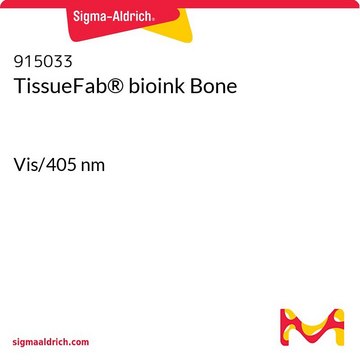おすすめの製品
類似した製品をお探しですか? 訪問 製品比較ガイド
関連するカテゴリー
アプリケーション
TissueFab® - Bone support bioink is suitable for printing bone scaffold or using as a supporting bioink for bone specific hydrogel/matrix bioink. It is formulated with optimal ratio of PCL and HAp, which shows excellent printability and osteogenic bioactivity. Polycaprolactone (PCL) is a synthetic biodegradable polymer that has been widely used as 3D printed bone scaffold material. Hydroxyapatite (HAp) has a chemical similarity with the mineralized phase of bone which accounts for their excellent biocompatibility and osteoinductive and osteoconductive properties favorable for bone regeneration.
包装
5g in glass bottle
法的情報
TISSUEFAB is a registered trademark of Merck KGaA, Darmstadt, Germany
保管分類コード
11 - Combustible Solids
WGK
WGK 3
適用法令
試験研究用途を考慮した関連法令を主に挙げております。化学物質以外については、一部の情報のみ提供しています。 製品を安全かつ合法的に使用することは、使用者の義務です。最新情報により修正される場合があります。WEBの反映には時間を要することがあるため、適宜SDSをご参照ください。
Jan Code
915637-VAR:
915637-BULK:
915637-5G:
最新バージョンのいずれかを選択してください:
Liang Dong et al.
Scientific reports, 7(1), 13412-13412 (2017-10-19)
Synthetic polymeric scaffolds are commonly used in bone tissue engineering (BTE) due to their biocompatibility and adequate mechanical properties. However, their hydrophobicity and the lack of specific cell recognition sites confined their practical application. In this study, to improve the
Boontharika Chuenjitkuntaworn et al.
Journal of biomedical materials research. Part A, 94(1), 241-251 (2010-02-19)
Polycaprolactone (PCL) is a synthetic biodegradable polymer that has been approved for use as bone graft substitutes. In this study, PCL scaffolds incorporating hydroxyapatite (HAp) particles were fabricated by combined solvent casting and particulate leaching techniques. The average pore dimension
Mitchell A Kuss et al.
RSC advances, 7(47), 29312-29320 (2017-07-04)
Reconstruction of complex, craniofacial bone defects often requires autogenous vascularized bone grafts, and still remains a challenge today. In order to address this issue, we isolated the stromal vascular fraction (SVF) from adipose tissues and maintained the phenotypes and the
ライフサイエンス、有機合成、材料科学、クロマトグラフィー、分析など、あらゆる分野の研究に経験のあるメンバーがおります。.
製品に関するお問い合わせはこちら(テクニカルサービス)







